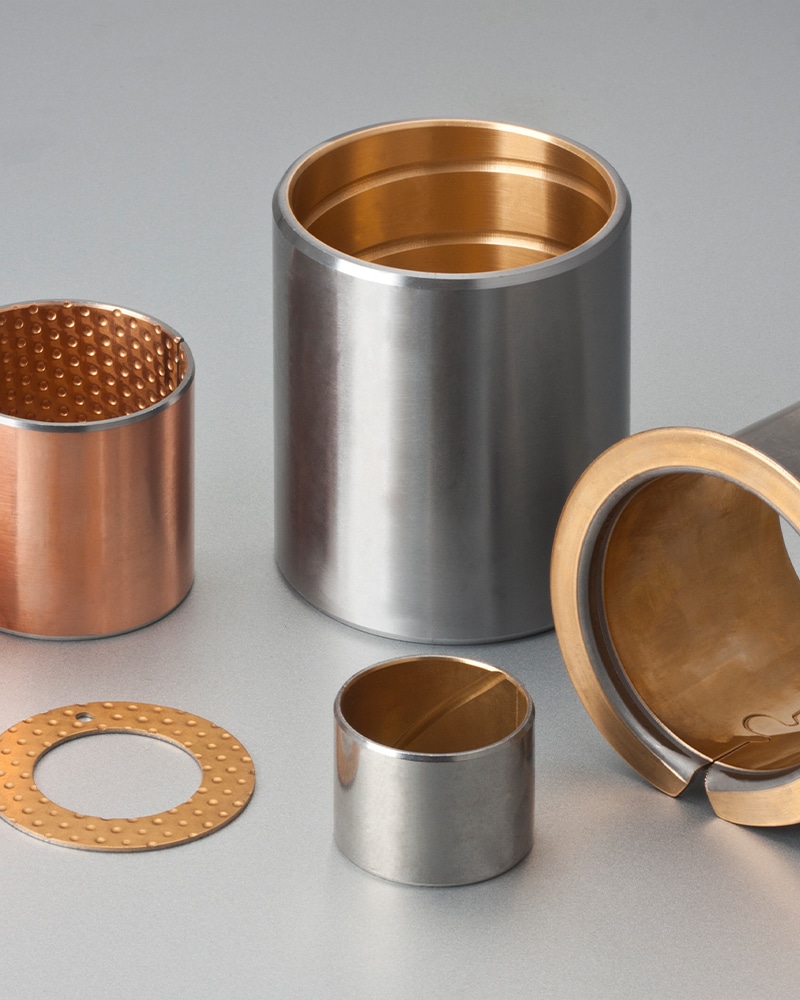lead free bushing
Bearings and Bushings for the Future: Precision and Customization: Our company, in bearing engineering with decades of experience, designs and develops high-precision self-lubricating bronze bearings & plain bushes. We offer a wide array of sliding bearings tailored to meet specific needs. Renowned for our expertise in custom bronze bushing and slide plate solutions, we provide an expansive selection of bushing metal alloys. Contact us today to benefit from unparalleled services at competitive prices.
lead free bushing
Explore Other Alloys, Suggested Searches: Copper Brass Bronze Copper Nickel
Bearing Bushing, Search Our Material Alloy
Embracing the Future with Lead-Free Bushing and PTFE-Free Bimetal Flange Collar Bearings
As industries evolve, the demand for sustainable, efficient, and environmentally friendly materials and components becomes more critical. Among these, lead-free bushing and PTFE-free bimetal flange collar bearings are gaining significant attention. These components are designed to eliminate PFAS (Per- and Polyfluoroalkyl Substances), offering a safer alternative without compromising on performance. This blog post delves into the benefits and applications of these innovative bearings, focusing on the metal-backed flange bearing made of steel and CuSn8Ni, ideal for medium load conditions.
The Shift Towards Lead-Free and PFAS-Free Bearings
Historically, lead and PFAS have been used in various industrial applications due to their desirable properties, such as durability and resistance to wear and tear. However, the environmental and health hazards associated with these substances have led to a global push towards safer alternatives. Lead-free bushings and PTFE-free bearings are at the forefront of this shift, providing a sustainable solution without sacrificing performance.
Metal-Backed Flange Bearings: A Closer Look
Metal-backed flange bearings, particularly those made from steel and CuSn8Ni, are designed for robustness and reliability. The combination of steel backing and a CuSn8Ni overlay offers excellent wear resistance and load-carrying capacity, making them ideal for medium load conditions.
Key Features:
- Lead-Free Composition: By eliminating lead, these bearings contribute to a safer working environment and reduce the environmental impact.
- PTFE-Free: The absence of PFAS ensures compliance with stringent environmental regulations and eliminates potential health risks associated with these substances.
- High Durability: The CuSn8Ni alloy (Copper-Tin-Nickel) provides exceptional strength and hardness (69-90HB), ensuring long-lasting performance under medium load conditions.
- Bimetallic Construction: The combination of a steel backing and CuSn8Ni overlay offers superior structural integrity and resistance to deformation.
- Versatility: These bearings are suitable for a wide range of applications, from automotive to industrial machinery, where medium load conditions are prevalent.
Applications of CuSn8Ni Bimetallic Bearings
CuSn8Ni bimetallic bearings are versatile and can be used in various sectors, including:
- Automotive Industry: Ideal for use in engine components, transmission systems, and suspension parts where medium load conditions are common.
- Industrial Machinery: Suitable for machinery that requires reliable and durable bearings to handle medium loads and reduce maintenance downtime.
- Aerospace: Used in aircraft components where reliability and safety are paramount, and lead-free, PTFE-free materials are preferred.
- Renewable Energy: Employed in wind turbines and other renewable energy applications that require environmentally friendly materials.
Conclusion
The transition to lead-free bushing and PTFE-free bimetal flange collar bearings marks a significant step towards sustainability and safety in industrial applications. The use of steel-backed CuSn8Ni bearings not only meets the demands of medium load conditions but also aligns with global efforts to reduce environmental impact and enhance human health. As industries continue to innovate, these advanced bearings will play a crucial role in shaping a safer and more sustainable future.
For more information on how lead-free and PTFE-free bearings can benefit your specific applications, feel free to contact us or visit our website.

Graphite Slide Plates, Bronze Pads
different thickness thick graphite bronze pads, custom bronze plate. slide plate
Providing Brass, Bronze, and Specialty Copper Alloys, Copper Alloy Machining Services

Solutions For Every Industry
Searching for Dependable Bushing Solutions? viiplus Has What You Need.

Design Guides, Materials
Bushing design, Comprehensive design manuals covering a range of self-lubricating materials used in all of viiplus’s manufacturing processes.

Technical Guides
Manufacturing On Demand, Technical Guides For Machining Design. Discover the latest in metal alloys, materials, and design tips for manufacturing custom machined and self-lubricating bearing parts.

Get Instant Quote
To receive your instant quote, simply upload your drawing file and choose your production process & bushing material.

Prototyping, Place Order
After you place your order, we will start the production process. You will receive updates when your order has completed production and is ready to be dispatched.

Receive Your custom Parts
We provide precision-inspected high-quality parts, packing lists and documents, and delivery tracking.

